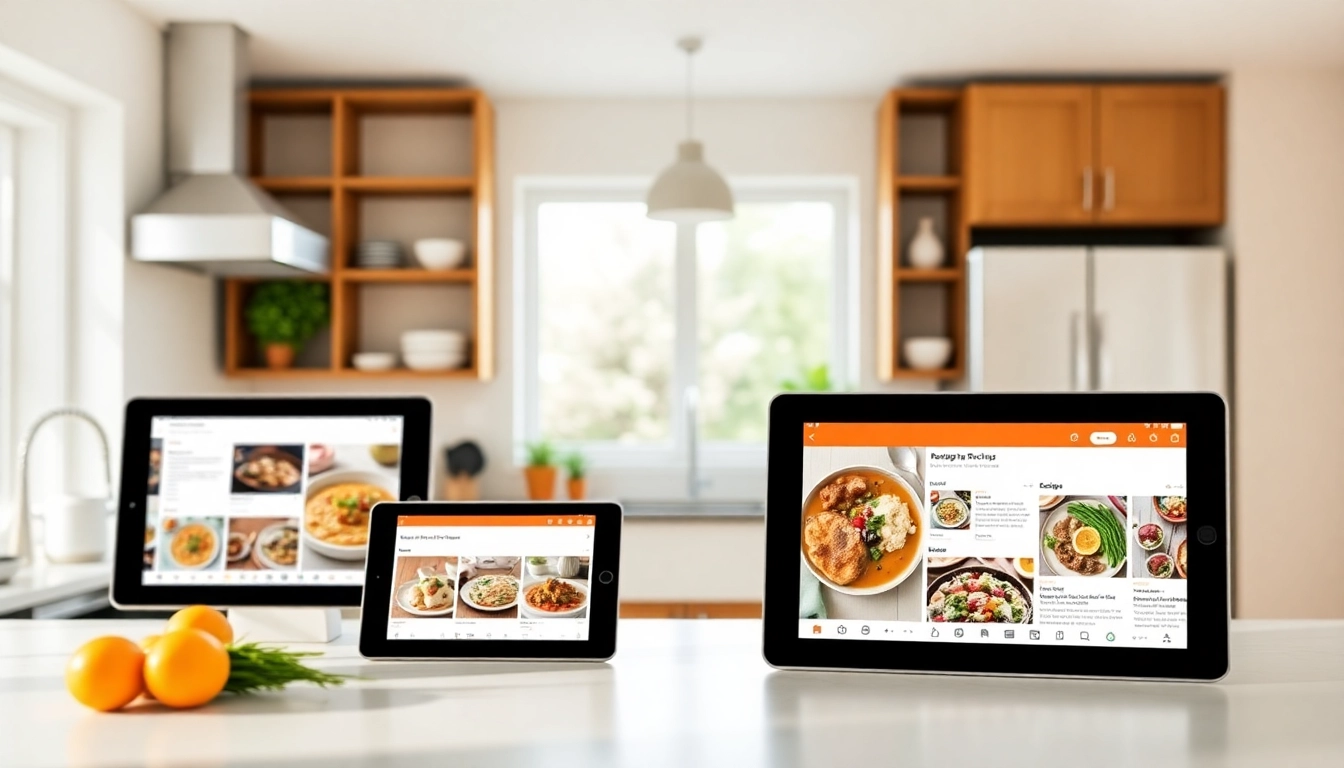Streamline Your Cooking: The Complete Guide to an Effective Recipe Manager Tool

Understanding the Role of a Recipe Manager in Modern Kitchens
In the culinary world, efficiency, organization, and accessibility are key to transforming cooking from a chore into an enjoyable experience. As the number of recipes accumulated from various sources continues to grow, managing them effectively becomes increasingly important. This is where a recipe manager plays a crucial role. Modern kitchen enthusiasts and professional chefs alike rely on these digital tools to streamline their culinary workflows, ensuring that favorite recipes are always at their fingertips, organized, and easy to share. Understanding what a recipe manager entails and how it functions can significantly elevate your cooking routine, making meal planning and ingredient sourcing more intuitive and less stressful.
What Is a Recipe Manager and Why It Matters
A recipe manager is a specialized software or digital platform designed to help users store, organize, and access recipes in a structured manner. Unlike traditional methods—such as handwritten cookbooks or paper printouts—digital recipe managers offer advanced functionalities that enhance usability. They enable quick searches, categorization, tagging, and even meal planning integration, making them indispensable for serious home cooks and culinary professionals.
The importance of a recipe manager extends beyond simple storage; it encompasses the ability to streamline the entire cooking process. For instance, with a reliable recipe manager, you can import recipes from social media, websites, or shared email links, then sync this culinary content to your preferred platforms like Evernote, Notion, or dedicated cooking apps.
To stay competitive and keep up with evolving culinary trends, many users are transitioning to comprehensive tools like Cooksync, which acts as a transport layer—an innovative solution that consolidates recipes from various sources without creating redundant data storage islands. Instead, it acts as a hub, feeding recipes into your favorite apps and platforms seamlessly, giving you ultimate control.
Common Features and Benefits of Leading Recipe Management Apps
Top-tier recipe management apps share core features that elevate the cooking experience. Understanding these can help you select the right tool tailored to your needs:
- Import capabilities: The ability to import recipes from websites, social media, and other digital sources saves time and maintains consistency in your collection.
- Organizational tools: Tagging, categorization, and advanced search functionalities facilitate quick access. For example, you might tag recipes by dietary restrictions, occasion, or main ingredient.
- Meal planning & shopping lists: Integrated calendars and grocery list generators streamline meal prep and shopping, reducing waste and ensuring you never forget an ingredient.
- Cross-device synchronization: Modern apps sync across smartphones, tablets, and desktop platforms, ensuring your culinary data is accessible anytime, anywhere.
- Data control & privacy: Leading apps prioritize user privacy, allowing complete control over your imported recipes and data sharing settings.
For example, Paprika—one of the most popular apps—provides these features alongside a built-in browser for direct recipe saving, meal planning tools, and grocery list creation, making it a comprehensive kitchen companion.
Benefits include organized recipe collections, streamlined meal prep, enhanced creativity through curated suggestions, and the ability to discover new dishes inspired by recipes from around the globe.
How a Recipe Manager Can Simplify Meal Planning and Organization
Effective meal planning involves selecting recipes, calculating ingredients, and timing preparation—tasks that become overwhelming without proper organization. A robust recipe manager automates much of this process.
By centralizing your recipes, such tools enable you to create menus for the week or specific events with ease. You can categorize recipes based on dietary preferences, cooking time, difficulty level, or cuisine type. Combining this with grocery list features, the app automatically compiles shopping items aligned with your planned meals.
For instance, when you import a recipe from a website using Cooksync’s seamless integration, it can be auto-synced with your preferred storage platform, such as Evernote or a dedicated cloud service. This means your recipe is always ready for batch cooking or quick reference during dinner preparations.
Over time, these tools facilitate smarter shopping—reducing duplicates and leftovers—by correlating recipes and ingredient usage, thereby saving money and minimizing waste.
Choosing the Right Recipe Manager for Your Needs
Key Factors to Consider: Compatibility, Accessibility, and Data Control
Not all recipe management solutions are created equal. When selecting a tool, consider the following critical factors:
- Platform Compatibility: Ensure the app supports your devices—be it iOS, Android, Windows, or Mac—to synchronize your recipes effortlessly.
- Ease of Import & Export: Look for solutions that can import recipes from websites, social media, or existing digital files, and export to various formats if needed.
- Data Privacy & Control: Opt for a platform that prioritizes user ownership of data, allowing you to retain control over your recipes without unnecessary cloud lock-in.
- Integration Capabilities: The best recipe managers connect seamlessly to other platforms like Evernote, Notion, or your preferred storage services.
- Cost & Subscription Models: Evaluate whether the platform offers transparent pricing, free trials, and flexible subscription options that fit your budget.
For example, Cooksync excels in these areas by providing extensive platform support, easy import/export options, and a transparent, one-plan pricing model—making it an ideal choice for both casual cooks and culinary pros.
Comparing Popular Recipe Managers: Features, Pricing, and Platforms
A comparative analysis reveals how the top recipe managers stack up:
| Feature | Paprika | RecipeSage | CookBook | Cooksync |
|---|---|---|---|---|
| Platform Support | iOS, Android, macOS, Windows | Web, iOS, Android | iOS, Android, Web | Any platform via sync (web, mobile, cloud platforms) |
| Import Capabilities | Built-in browser, manual import | Web scraping, manual | Manual, import from files | Websites, social media, manual links |
| Pricing | Subscription (~$2.99/month) | Free with donation options | One-time or subscription | Affordable plans, monthly or yearly |
| Sync & Storage | Cloud sync, local storage | Cloud sync | Cloud-based | Syncs to preferred platforms; acts as hub |
Overall, selection depends on your device ecosystem, budget, and whether you prioritize comprehensive features or simple usability.
Integrating Your Favorite Platforms for a Unified Culinary Hub
The power of a recipe manager lies in its ability to connect with your existing digital ecosystem. Platforms like Cooksync serve as an intermediary—an elegant transport layer—allowing recipes to flow smoothly into your preferred note-taking or storage apps such as Evernote, Notion, or specialized cooking solutions.
This approach prevents duplication, ensures your recipes are always up-to-date, and simplifies data management. For instance, you can import recipes via Cooksync’s Chrome extension or mobile app, and then automatically sync them to your chosen platform. This seamless integration makes your digital culinary collection consistent and accessible across devices.
Moreover, these integrations support a variety of platforms, and Cooksync is continually expanding its list, making it a future-proof choice.
Setting Up Your Recipe Manager for Optimal Use
Importing Recipes from Websites, Social Media, and Other Sources
The foundation of a personalized digital cookbook is the ease of importing recipes. Modern tools offer multiple methods:
- Browser extensions: Using Chrome extensions, users can clip recipes directly from food blogs and culinary websites, preserving formatting and images.
- Mobile applications: The Cooksync iOS app allows instant sharing from social media or photo libraries as digital recipes.
- Manual additions: For recipes outside digital sources, manual entry or link sharing ensures your collection remains comprehensive.
For example, importing a recipe from a popular food site becomes as simple as clicking a button in your extension, after which it automatically formats and prepares the recipe for synchronization.
Organizing and Tagging Recipes for Easy Access
Once imported, organization is crucial. Tagging recipes by meal type, main ingredients, dietary restrictions, or occasion allows faster retrieval. Think of tags like keywords that filter your collection efficiently.
Modern apps support batch tagging, custom categories, and search filters. For instance, you might tag a recipe “Vegetarian,” “Dinner,” and “Gluten-Free,” making it readily available when planning a special meal.
Consistent organization reduces time spent hunting for recipes during busy weeknights or celebrations, turning recipe access from a chore into a quick, enjoyable step.
Connecting and Syncing to Your Preferred Storage Space
Syncing your recipe collection to your preferred storage space ensures centralized access. Cooksync offers extensive platform support, enabling you to connect to Evernote, Notion, Google Drive, or even custom storage servers.
The setup process involves linking your accounts within Cooksync and configuring sync preferences. Once done, recipes you import are automatically sent to these platforms, keeping your culinary library current across your devices.
This flexibility ensures you maintain full control over your data, avoiding vendor lock-in or proprietary formats. Plus, it simplifies backup and sharing processes, as your recipes reside where you already work or plan meals.
Maximizing Your Recipe Manager’s Potential
Personalizing Recipe Suggestions to Spark Creativity
Many recipe managers incorporate intelligent suggestion algorithms based on your collection and browsing habits. Personalized recommendations inspire new dishes, prevent stagnation, and fuel culinary creativity.
For example, Cooksync analyzes your imported recipes to suggest similar dishes, trending recipes within your network, or seasonal specialties. This feature keeps your culinary ideas fresh and makes meal planning more engaging.
Additionally, receiving weekly suggestions tailored to your taste preferences helps discover cuisines or dietary options you may not have previously considered.
Keeping Your Digital Cookbook Up-to-Date and Secure
Maintaining an up-to-date recipe collection involves regular imports, edits, and backups. Cloud sync ensures your recipes stay current across all devices, while robust security measures—such as end-to-end encryption and privacy controls—prevent unauthorized access.
To further safeguard your data, select apps and platforms that clearly state their privacy policies, allow selective sharing, and provide data export options.
For example, Cooksync allows you to export your entire recipe collection at any time, ensuring ownership and portability of your culinary data.
Tracking Usage and Improving Your Culinary Workflow
Advanced users can leverage analytics features or manual tracking to understand cooking habits and recipe performance. Metrics such as frequently used recipes, time taken, or ingredient costs help optimize meal planning.
Incorporating feedback or reviews on recipes can guide future culinary experiments, ensuring continual improvement.
For instance, tracking which recipes are most popular during a specific period assists in planning themed dinners or seasonal menus effectively.
Advanced Tips for Power Users
Automating Routine Tasks with Custom Exports and Integrations
Power users can automate additives to their culinary workflow via custom scripts, API integrations, or scheduled exports. For example, setting up routines to export weekly meal plans to a calendar or a shopping list app reduces manual effort.
Platforms like Cooksync facilitate such automation by offering API access or integration with automation tools like Zapier, enabling customized workflows tailored to your cooking habits.
Using Data Analytics for Better Meal Planning
Leveraging collected data allows for smarter planning—identifying ingredient usage trends, seasonal flavors, or recipe popularity peaks. This data-driven approach informs purchasing decisions and menu diversification.
Visualization tools, dashboards, or simple reports within your recipe manager can highlight insights like “Most cooked recipes of the month” or “Remaining pantry ingredients,” optimizing your culinary resources.
Exploring Future Trends in Recipe Management Technology
The future of recipe management involves integration with voice assistants, AI-generated recipes, augmented reality (AR) cooking guides, and smarter ingredient AI suggestions. As technology advances, these innovations promise to make cooking more intuitive, personalized, and engaging.
Staying ahead involves adopting platforms that embrace these trends, like Cooksync’s ongoing expansion of supported integrations and intelligent features, ensuring your kitchen remains future-proof.


